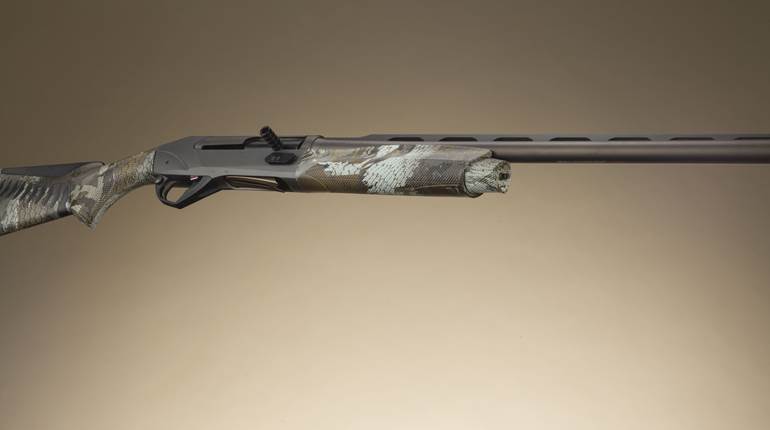
The Bushmaster ACR is a firearm both propelled and burdened by its legacy as the Magpul Masada. First unveiled at the 2007 SHOT Show in Orlando, Fla., the gun created quite a stir among the semi-automatic rifle aficionados in attendance. The Masada promised to deliver first-rate ergonomics and versatility in the form of its quick-change barrel capability and adaptability to alternate calibers.
Magpul had something good but it didn’t have the resources to produce the gun, so in 2008 it sold the design to Bushmaster, which re-named the firearm Adaptive Combat Rifle (ACR). Bringing a gun like the Masada to market would be a tough job, but Bushmaster and Remington, both members of the Freedom Group family of firearm companies, shared their resources and unique expertise to make the promise of the Masada a reality. Magpul may have sold its rights to the gun, but it remained heavily involved in the development of the ACR.
Bushmaster and Remington will both sell ACRs. Bushmaster will handle civilian and state and local law enforcement sales, while Remington will handle potential ACR sales to federal law enforcement and the military. Bushmaster will offer two models, the Basic and the Enhanced, with the only significant differences being the stock and the fore-end. The Basic will have a fixed stock and polymer fore-end and the Enhanced will have a folding stock and a quad-rail aluminum fore-end. I received an Enhanced ACR for examination and testing.
A Better Mousetrap
The ACR dispenses with the direct gas-impingement operating system of the M16 in favor of an AR-180-style indirect gas-impingement system. Gas tapped from a port in the barrel travels through the gas block and impinges on a tappet rod above the barrel. Energy from the expanding propellant gases drives the tappet rod back. The tappet rod in turn strikes the face of the bolt carrier to unlock the bolt.
The ACR has a short-stroke rotary bolt with eight equally spaced locking lugs that engage an extension on the breech end of the barrel. Seven of the lugs have the same height, width and depth, while a smaller eighth lug is part of the extractor. A plunger ejector can be found on the recessed bolt face. There are no gas rings on the bolt body, as it’s not a direct-gas gun, so it doesn’t need them. A coil spring wrapped around the steel firing pin reduces the chances of a slam fire. Rotation of the bolt is controlled by a cam pin that travels in a kidney shaped cut-out in the left side of the carrier.
The bolt carrier slides on a single action rod that controls the compression of the recoil spring. A white polymer buffer is fixed to the tail of the action rod. U-shaped steel guide rails anchored to the aluminum upper receiver by machine screws control the vertical and horizontal movement of the bolt carrier as it travels back and forth during the firing cycle.
The advantages of the ACR’s operating system are: It has no need for a separate buffer extension, so it is compatible with a folding stock; the travel of the blocky bolt carrier is less likely to be impeded by dirt or accumulated fouling in the upper receiver; and much less fouling and heat is vented into the bolt and action mechanism during firing. Most of the fouling is trapped in the gas block. Thankfully, the two-position gas regulator, along with the tappet rod and action spring, can be removed for cleaning. The two-position regulator can be rotated in either a clockwise or counter-clockwise direction. The “S” setting is for firing with an attached suppressor and “U” setting is for normal unsuppressed operation.
Quick-Change Barrel
The standard barrel length for both the Basic and Enhanced models is 16 1/2 inches. Remington representatives told me that their internal testing determined the barrel’s ideal thickness and stepped profile for maximum longevity. The 10 1/2- and 14 1/2-inch-barreled guns will be available to law enforcement customers and Bushmaster will offer 18-inch-heavy barreled guns as Designated Marksman-style rifles. Most of the shooters I know who are eager to buy an ACR will likely want to shoot it with 75- and 77-grain loads, so the 1:9-inch rifling twist of our test gun seems to be an odd choice. Bushmaster told me that 1:9 inches was the most popular choice among its distributors, but I was assured that guns with 1:7-inch barrels will be available, and separate 1:7-inch barrels will be available through a spare barrel program. Also 6.8x43 mm barrels with Spec. II chambers will be introduced in the same lengths. All ACR barrels in both chamberings are cold-hammer forged with six grooves in a right-hand twist.
A barrel nut with interrupted threads locks the barrel assembly into a steel trunnion fixed to the upper receiver by way of two roll pins and two machine screws. A hinged barrel wrench attached to the barrel nut makes it easy to dismount the barrel for cleaning or swapping calibers. It should be noted that a caliber change will also require replacing the bolt and magazine.
To change the barrel, simply lock the bolt to the rear. Knock out the captured ferule pin at the bottom rear of the aluminum fore-end. Pull the U-shaped fore-end forward and off of the gun. Pull down on the hinged barrel wrench and rotate the barrel wrench/barrel nut lever one-quarter turn to the left. Then unseat the barrel nut from the trunnion by pulling forward on the barrel wrench. The barrel assembly and the attached gas system assembly can then be removed.
Construction
The upper receiver is a U-shaped, one-piece assembly of extruded aluminum that extends from the wrist of the stock to the gas block. An integral M1913 Picatinny rail runs the full length of its roof. A shell deflector is mounted behind its large ejection port. The upper receiver also serves as a housing for the reversible charging handle, the bolt, and the steel trunnion that provides a common joint for the ACR’s upper and lower receivers and its detachable barrel.
Magpul specializes in polymer accessories for the AR-15/M16 platform, and the ACR’s polymer lower receiver is a legacy of its Magpul origins. The lower receiver consists of an integral pistol grip, trigger well and magazine well. All of the fire and function controls including the trigger, ambidextrous safety lever, ambidextrous magazine release and bolt stop buttons are contained in the ACR’s lower receiver. It also serves as a mounting point for the buttstock, which is held in place by both a tongue-and-groove joint and a captured steel ferule pin at the rear of the assembly. Like the M16, the upper and lower receivers are hinged on a captured pivot pin in front of the magazine well. Unlike the M16, the rear take-down pin is housed in the upper rather than the lower receiver.
The skeletonized polymer stock of the ACR Basic is fixed with a 12-inch length of pull that can be extended with compatible inserts from Magpul. In contrast, the stock of the Enhanced is adjustable in every way imaginable. The comb can be raised a 1/2 inch and the user can choose one of seven settings for length of pull, ranging from 11 to 14 inches in 1/2-inch increments. A push-button release on the left side of the stock near the wrist allows the stock to fold over the right side of the receiver. When folded, it is held in position by tension but doesn’t really lock. This is something of a compromise that allows it to lock back in its extended firing position without pushing any buttons. When folded, the stock does not block the ejection port, but shooters may find that it impairs access to some of the left-handed controls on the right side of the receiver including the safety lever and magazine release button. Battery storage compartments are included in the stock and pistol grip. They are compatible with most of the Magpul MIAD Grip Core inserts.
Exemplary Ergonomics
The ACR’s construction and design are rugged and reliable, but they are not revolutionary. Most of the components and operating principles, such as the heavy bolt and indirect gas-impingement operating system, are designs with proven histories, but what really sets the ACR apart from older designs are its ergonomics. For example, both the magazine release and the bolt stop buttons can be worked with the trigger finger, and they are also completely ambidextrous. Mirrored magazine release buttons can be found on both sides of the lower receiver just above the front of the trigger well. The buttons are large, square and grooved for easy activation and fenced to reduce the chances of their being accidentally depressed. The bolt stop release is of a design first seen on the Robinson Arms XCR. Located between the front of the trigger well and the rear of the magazine well, the bolt stop releases have a stepped contour that leaves them raised at their centers. Pushing up on either button engages the bolt stop. Pressing down releases it. Additionally, the rising follower of an empty magazine automatically activates the bolt stop, so the bolt stays open after the last round is fired. The ambidextrous safety lever can be worked with the thumb of the firing hand. The safety lever rotates easily throughout its 90-degree travel without binding, yet it positively engages both the “safe” and “fire” settings.
One change in the layout of the controls from the original Magpul Masada is the location of the charging handle. Much like that of the H&K MP5, the non-reciprocating handle moves in a slot running along the top half of the fore-end. The polymer handle has a grooved face and is reversible for left-handed use. The handle is hinged, which improves its performance as a forward assist in the event that the bolt should fail to fully seat into battery. Bushmaster representatives tell me that a universal variant of the charging handle that extends out both sides of the receiver will be available as an accessory. Positioning the charging handle in front of the action makes it easy to work it with the support hand, so the shooter doesn’t have to re-establish the grip of his strong hand; this allows the user to keep his head on the stock and thus keep his eyes on target as he works the bolt to reload or reduce a stoppage.
Other ergonomic touches include grip-enhancing texturing on the side panels of the magazine well and pistol grip. The stocks of both the Basic and Enhanced ACRs have a Quick Detach sling coupler near the joint of the heel and the comb. The QD coupler on the stock can be swapped to the opposite side if so desired. QD couplers are also found forward, just above the hinge pin where the barrel and the upper and lower receivers join the trunnion and on the vertical walls of the free-floating fore-end just to the rear of the gas block. The Enhanced ACR comes with a push-button sling from Blue Force Gear that snaps right on (the Basic ACR does not come with a sling).
The ACR’s sights have not been overlooked, either. Both the Basic and Enhanced ACRs come with Magpul MBUS back-up sights. They fold down when not in use, but wings on both sides of the front and rear sights can be quickly deployed with the thumbs of the firer’s shooting and support hands. The rear aperture is screw-adjustable for windage and the front post can be adjusted for elevation with the tip of a bullet or a special purpose tool. The rear sight has two apertures. The smaller aperture is optimized for 100 to 300 meters, and the larger aperture is intended for what the manual calls “Short Range,” or out to 100 meters.
About the only ergonomic disappointment may be the integral pistol grip. It’s raked at a good angle and its size and contour should be compatible with most hand sizes, but it’s not hard to imagine something better. Representatives from Remington tell me that they are developing an aluminum lower receiver for the ACR. Its pistol grip will be a separate component and thus easily replaceable.
Rugged Performance
When word spread that the bore wasn’t chrome-plated, it led the shooting public to suspect that endurance testing had been given short shrift. In reality, nothing could be further from the truth. Remington, Bushmaster and Magpul collaborated throughout the development of the gun. Given that the military version of the ACR is intended to compete in upcoming military trials as an alternative to the M4, it was designed for maximum durability and reliability. Extensive environmental and endurance testing is much of what delayed its release.
Toward that end, Remington developed a proprietary finish for use in both the Remington and Bushmaster ACRs. Impregnated with a dry lubricant, the new finish will be applied to the inside of the bore and to all of the working components of the gun. Remington claims its new finish resists corrosion and doubles the service life of the bore. Additionally, it dispenses with the need for any additional lubrication. Needless to say, this limits the accumulation of carbon- and environment-based fouling.
The gun is made without an ejection port cover. Keeping dirt out of a self-loading firearm was seen as a vain effort; instead, the ACR was designed to shed any dirt and sand that gets in. Looking down through the ejection port, one can see a gap between the bolt carrier and the receiver wall. Gaps like this are meant to aid the egress of sand, mud and water.
Shoot It And Shoot It Some More
The trigger of the ACR is pretty much identical to any standard single-stage unit you’ll find in an AR-15-style rifle. About the only difference is that it is housed in a removable chassis rather than mounted on pins in the lower receiver. I’m told that Remington and Bushmaster plan to make two-stage units available in the near future. The trigger of my sample gun broke at slightly more than 6 pounds of pull weight. Trigger travel was commendably smooth, there was no stacking and minimal overtravel.
For accuracy testing I mounted a 6X Leupold M8 Compact with adjustable parallax in a steel base and ring combination mount from ArmaLite. Accuracy results compare favorably with most AR-15-style tactical rifles I’ve tested in the past. Given the barrel’s 1:9-inch twist rate I stuck to loads with bullets weighing 55 grains or less.
Remington supplied a prototype 6.8x43 mm barrel, bolt and magazine for function testing, but time constraints kept me from performing a complete accuracy test in that caliber. I can say that the ACR retained its zeroes after caliber swaps and the gun functioned flawlessly in both calibers. There were no failures to feed, fire or eject.
It was in rapid-fire shooting drills that the ACR revealed its true beauty. All of the controls are within easy reach and engaged and disengaged without any binding or slop. The supplied Magpul PMAG 30-round magazines fed flawlessly, consistently engaged the bolt stop and dropped free of their own empty weight. The layout of the controls made for smooth reloads and rapid reduction of induced stoppages. As a southpaw, I was pleased that the ACR’s shell deflector kept ejected cases well away from my face.
Was the ACR worth the wait? To my way of thinking, the question is moot. Bushmaster didn’t tie up anyone’s money by taking orders it wouldn’t be able to fill or leave anyone hopelessly unarmed. The ACR also didn’t become obsolete or antiquated during the time it was in development. So I don’t see any point in judging the Bushmaster ACR on anything other than its merits. The gun certainly delivers on performance and handling, and given the speed with which one can change the barrel, it is certainly adaptable. Remington’s proprietary coating for the ACR that dispenses with the need for lubrication is certainly promising, but it is a feature that adds to the cost. Without it, the gun would be less expensive, but the last thing Bushmaster and Remington wanted to do was release a “beta” version of the ACR that didn’t perform like the real thing. The ACR is expensive, and certainly far more expensive than anyone expected, but it is also a one-of-a-kind rifle.
Manufacturer: Bushmaster Firearms Int’l LLC; (800) 998-7928; Bushmaster.com
Caliber: 5.56x45 mm NATO/.223 Rem. (tested), 6.8x43 mm SPC II
Action Type: Gas-operated, semi-automatic center-fire rifle
Receiver: Extruded aluminum upper, polymer lower
Barrel: 161⁄2" cold-hammer forged chrome-moly steel
Rifling: 1:9" (tested), also available in 1:7"
Magazine: Detachable box, compatible with AR-15/M16
Sights: Rear aperture adjustable for windage, front post adjustable for elevation, M1913 Picatinny rail for scope mounting
Trigger: Single-stage; 6-lb., 2-oz. pull
Stock: Length of pull, 11" to 14"; drop at heel, 1/2"; drop at comb, adjustable between 1/2" and 1/8"
Overall Length: 333⁄4" (stock folded), 363⁄4" (stock extended)
Weight: 8 lbs., 3 ozs.
Accessories: Three 30-round Magpul PMAG magazines
Suggested Retail Price: Enhanced ACR $3,031 (tested), Basic $2,685























![Auto[47]](/media/121jogez/auto-47.jpg?anchor=center&mode=crop&width=770&height=430&rnd=134090788010670000&quality=60)
![Auto[47]](/media/121jogez/auto-47.jpg?anchor=center&mode=crop&width=150&height=150&rnd=134090788010670000&quality=60)












